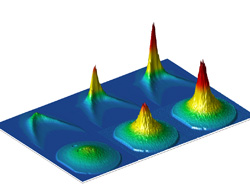Bose-Einstein condensation of polaritons brings quantum effects in out of the cold

Images of the energy distribution of polaritons as a function of the excitation density. From left to right, below threshold for condensation, at threshold and above threshold. Front row, speed distributions, the speed increases from the center to the edges. Rear row, dispersion of polaritons, with their distribution.
The creation of a polariton Bose-Einstein condensate in the solid state provides scientists with a unique opportunity to better understand and possibly exploit the quantum effects that occur in these very special conditions.
Researchers at EPFL (Ecole Polytechnique Federale de Lausanne), collaborating with colleagues at University of Grenoble, Cambridge, Oxford and MIT, have reported the observation of polaritons displaying the defining features of Bose Einstein condensation –a macroscopically ordered state, long-range spatial coherence and polarization – for the first time in solid state. Their results appear in an article in the September 28 issue of the journal Nature.
Bose-Einstein condensates are sometimes referred to as a “fifth state of matter”, a special phase in which all the particles share the same quantum state. This phase was predicted by Satyendranath Bose and Albert Einstein in 1924. Getting atoms cold enough to provide experimental proof of its existence took seventy more years, and the first successful experiments using Rubidium atoms won Eric Cornell, Wolfgang Ketterle and Carl Wieman the 2001 Nobel prize in physics. Cooled to within a hair of absolute zero, the atoms in dilute clouds of bosonic gases stop moving and condense, not into a liquid, but into a new phase called a condensate, in which the atoms all share the same quantum state. Like photons in a laser, the particles are coherent, behaving en masse like a “super-particle.”
The possibility of a phase change into a Bose-Einstein-like condensate theoretically applies for all bosonic particles, including electron-hole pairs called excitons and half exciton, half photon quasi-particles called polaritons. Exploring Bose-Einstein condensation and its intriguing quantum effects using these quasi-particles is particularly interesting because their light mass makes things much easier. A polariton is a billion times lighter than a Rubidium atom, and 10,000 times lighter than an electron. This means that polaritons can transform into a Bose-Einstein condensate at a much higher temperature than alkali gases. Some of the possibilities that have been suggested for applications of the quantum effects of the Bose-Einstein phase — quantum computing, quantum clocks or atomic or lasers that use matter instead of light – are only realistically conceivable if these condensates can be achieved at room temperature, or at least temperatures that can be reached using standard cryogenic techniques.
Signatures of exciton and polariton coherence have been previously observed in semiconductor microcavities, but conclusive proof, such as evidence of polarization and long range particle coherence, has remained elusive because the particles only live a trillionth of a second.
The experiments of the EPFL-led team provide the first convincing evidence of a Bose-Einstein like condensate in the solid state. The researchers confined photons in a semiconductor microcavity containing a large number of quantum wells, and then used a laser to excite the semiconductor, generating polaritons. At a critical density, at the easily attainable temperature of 19 degrees Kelvin (about -254 Celsius), the polaritons showed evidence of spontaneous coalescence into a single coherent ground state. The classic phase transition characteristics — macroscopic polarization and spatial coherence across the entire condensate — are clearly seen here, and for the first time in solid state.
According to Professor Benoit Deveaud, leader of the research team, condensates at even higher temperatures could perhaps be achieved using other semiconductor materials.
“The magical properties of superfluidity, where matter flows with zero friction, and superconductivity, where a current flows with zero resistance, are quantum effects, and in the Bose-Einstein condensate they are directly brought to our perception,” notes Deveaud. “It is exciting to envision exploring this magic without having to use an incredibly complex machine to get to temperatures just above absolute zero.”
What practical applications will this lead to? “We are still exploring the basic physics of this phenomenon,” says Deveaud. “But just achieving this phase in the solid state is exciting. In the mid 1900s, transistors replaced vacuum lamps, and now most useful devices are made in the solid state,” he explains. “Polaritons, although made with a photon, are really quasi-particles in the solid. It is likely that they can be manipulated much as electrons are – an advance that has led to incredible new technologies such as the CCD chips in digital cameras.”
Media Contact
More Information:
http://www.epfl.chAll latest news from the category: Physics and Astronomy
This area deals with the fundamental laws and building blocks of nature and how they interact, the properties and the behavior of matter, and research into space and time and their structures.
innovations-report provides in-depth reports and articles on subjects such as astrophysics, laser technologies, nuclear, quantum, particle and solid-state physics, nanotechnologies, planetary research and findings (Mars, Venus) and developments related to the Hubble Telescope.
Newest articles

Superradiant atoms could push the boundaries of how precisely time can be measured
Superradiant atoms can help us measure time more precisely than ever. In a new study, researchers from the University of Copenhagen present a new method for measuring the time interval,…

Ion thermoelectric conversion devices for near room temperature
The electrode sheet of the thermoelectric device consists of ionic hydrogel, which is sandwiched between the electrodes to form, and the Prussian blue on the electrode undergoes a redox reaction…

Zap Energy achieves 37-million-degree temperatures in a compact device
New publication reports record electron temperatures for a small-scale, sheared-flow-stabilized Z-pinch fusion device. In the nine decades since humans first produced fusion reactions, only a few fusion technologies have demonstrated…





















